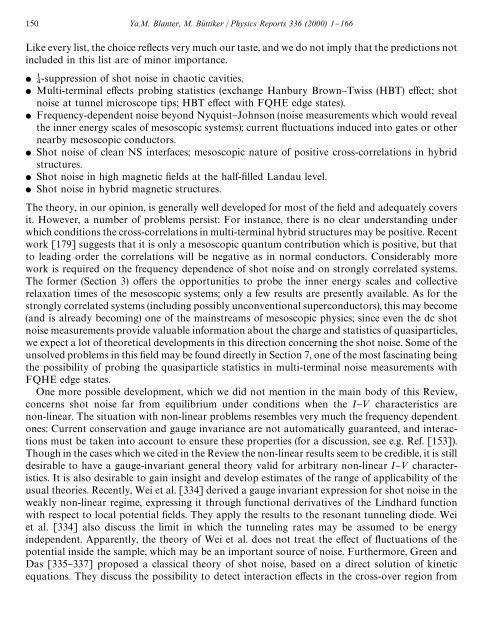shot noise in mesoscopic conductors - Low Temperature Laboratory
shot noise in mesoscopic conductors - Low Temperature Laboratory
shot noise in mesoscopic conductors - Low Temperature Laboratory
You also want an ePaper? Increase the reach of your titles
YUMPU automatically turns print PDFs into web optimized ePapers that Google loves.
150 Ya.M. Blanter, M. Bu( ttiker / Physics Reports 336 (2000) 1}166<br />
Like every list, the choice re#ects very much our taste, and we do not imply that the predictions not<br />
<strong>in</strong>cluded <strong>in</strong> this list are of m<strong>in</strong>or importance.<br />
-suppression of <strong>shot</strong> <strong>noise</strong> <strong>in</strong> chaotic cavities.<br />
Multi-term<strong>in</strong>al e!ects prob<strong>in</strong>g statistics (exchange Hanbury Brown}Twiss (HBT) e!ect; <strong>shot</strong><br />
<strong>noise</strong> at tunnel microscope tips; HBT e!ect with FQHE edge states).<br />
Frequency-dependent <strong>noise</strong> beyond Nyquist}Johnson (<strong>noise</strong> measurements which would reveal<br />
the <strong>in</strong>ner energy scales of <strong>mesoscopic</strong> systems); current #uctuations <strong>in</strong>duced <strong>in</strong>to gates or other<br />
nearby <strong>mesoscopic</strong> <strong>conductors</strong>.<br />
Shot <strong>noise</strong> of clean NS <strong>in</strong>terfaces; <strong>mesoscopic</strong> nature of positive cross-correlations <strong>in</strong> hybrid<br />
structures.<br />
Shot <strong>noise</strong> <strong>in</strong> high magnetic "elds at the half-"lled Landau level.<br />
Shot <strong>noise</strong> <strong>in</strong> hybrid magnetic structures.<br />
The theory, <strong>in</strong> our op<strong>in</strong>ion, is generally well developed for most of the "eld and adequately covers<br />
it. However, a number of problems persist: For <strong>in</strong>stance, there is no clear understand<strong>in</strong>g under<br />
which conditions the cross-correlations <strong>in</strong> multi-term<strong>in</strong>al hybrid structures may be positive. Recent<br />
work [179] suggests that it is only a <strong>mesoscopic</strong> quantum contribution which is positive, but that<br />
to lead<strong>in</strong>g order the correlations will be negative as <strong>in</strong> normal <strong>conductors</strong>. Considerably more<br />
work is required on the frequency dependence of <strong>shot</strong> <strong>noise</strong> and on strongly correlated systems.<br />
The former (Section 3) o!ers the opportunities to probe the <strong>in</strong>ner energy scales and collective<br />
relaxation times of the <strong>mesoscopic</strong> systems; only a few results are presently available. As for the<br />
strongly correlated systems (<strong>in</strong>clud<strong>in</strong>g possibly unconventional super<strong>conductors</strong>), this may become<br />
(and is already becom<strong>in</strong>g) one of the ma<strong>in</strong>streams of <strong>mesoscopic</strong> physics; s<strong>in</strong>ce even the dc <strong>shot</strong><br />
<strong>noise</strong> measurements provide valuable <strong>in</strong>formation about the charge and statistics of quasiparticles,<br />
we expect a lot of theoretical developments <strong>in</strong> this direction concern<strong>in</strong>g the <strong>shot</strong> <strong>noise</strong>. Some of the<br />
unsolved problems <strong>in</strong> this "eld may be found directly <strong>in</strong> Section 7, one of the most fasc<strong>in</strong>at<strong>in</strong>g be<strong>in</strong>g<br />
the possibility of prob<strong>in</strong>g the quasiparticle statistics <strong>in</strong> multi-term<strong>in</strong>al <strong>noise</strong> measurements with<br />
FQHE edge states.<br />
One more possible development, which we did not mention <strong>in</strong> the ma<strong>in</strong> body of this Review,<br />
concerns <strong>shot</strong> <strong>noise</strong> far from equilibrium under conditions when the I}< characteristics are<br />
non-l<strong>in</strong>ear. The situation with non-l<strong>in</strong>ear problems resembles very much the frequency dependent<br />
ones: Current conservation and gauge <strong>in</strong>variance are not automatically guaranteed, and <strong>in</strong>teractions<br />
must be taken <strong>in</strong>to account to ensure these properties (for a discussion, see e.g. Ref. [153]).<br />
Though <strong>in</strong> the cases which we cited <strong>in</strong> the Review the non-l<strong>in</strong>ear results seem to be credible, it is still<br />
desirable to have a gauge-<strong>in</strong>variant general theory valid for arbitrary non-l<strong>in</strong>ear I}< characteristics.<br />
It is also desirable to ga<strong>in</strong> <strong>in</strong>sight and develop estimates of the range of applicability of the<br />
usual theories. Recently, Wei et al. [334] derived a gauge <strong>in</strong>variant expression for <strong>shot</strong> <strong>noise</strong> <strong>in</strong> the<br />
weakly non-l<strong>in</strong>ear regime, express<strong>in</strong>g it through functional derivatives of the L<strong>in</strong>dhard function<br />
with respect to local potential "elds. They apply the results to the resonant tunnel<strong>in</strong>g diode. Wei<br />
et al. [334] also discuss the limit <strong>in</strong> which the tunnel<strong>in</strong>g rates may be assumed to be energy<br />
<strong>in</strong>dependent. Apparently, the theory of Wei et al. does not treat the e!ect of #uctuations of the<br />
potential <strong>in</strong>side the sample, which may be an important source of <strong>noise</strong>. Furthermore, Green and<br />
Das [335}337] proposed a classical theory of <strong>shot</strong> <strong>noise</strong>, based on a direct solution of k<strong>in</strong>etic<br />
equations. They discuss the possibility to detect <strong>in</strong>teraction e!ects <strong>in</strong> the cross-over region from
















